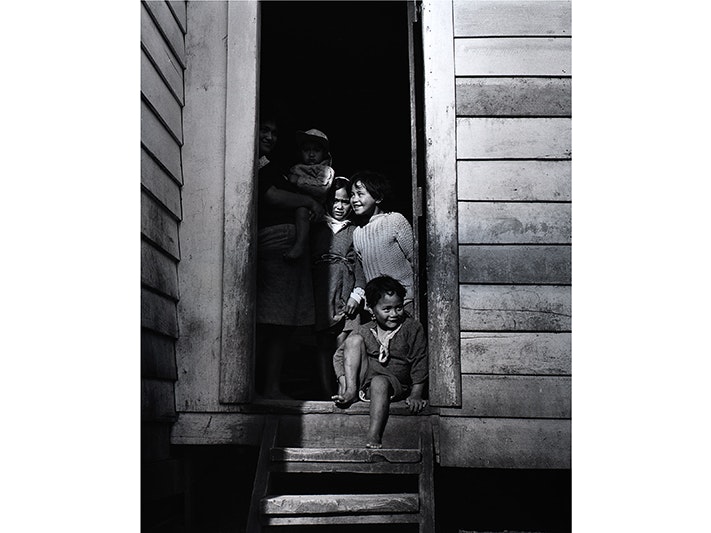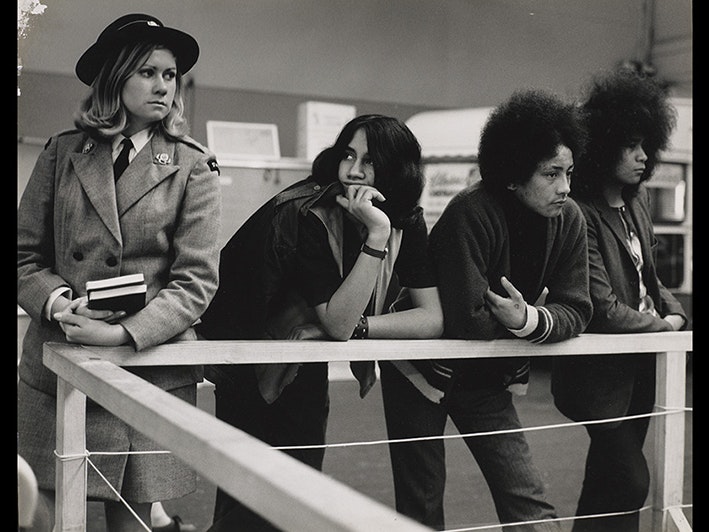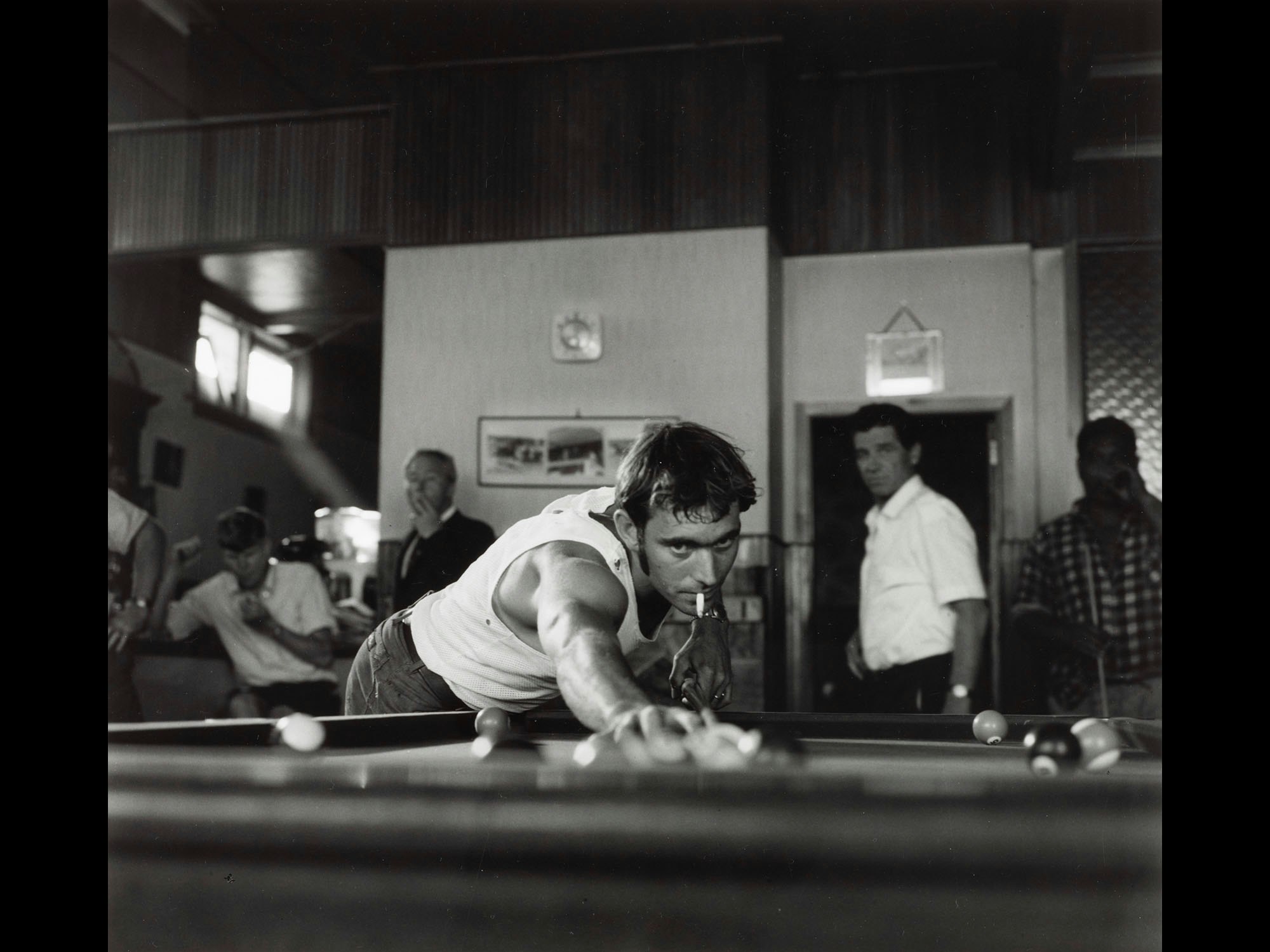
Ans Westra – ‘Washday at the Pa’ controversy
‘Washday at the Pa’ was a school bulletin published in 1964 by the Education Department’s School Publications section. It has faced criticism as well as praise since publication.
Free museum entry for New Zealanders and people living in New Zealand
Open every day 10am-6pm
(except Christmas Day)
Free museum entry for New Zealanders and people living in New Zealand
Ans Westra (28 April 1936 – 26 February 2023) is one of New Zealand’s best-known social documentary photographers.
Anna Jacoba Westra (Ans) was born in Leiden, Netherlands in 1936 and qualified as an arts and crafts teacher in Rotterdam. In 1954 she began taking photographs as a hobby, inspired by New York’s Museum of Modern Art landmark touring exhibition The Family of Man. In 1957, aged twenty-one, she arrived in New Zealand to visit her father, who had earlier migrated to this country.
Ans Westra, Self portrait, 1964, black and white photograph, gelatin silver print. Te Papa (O.042837)
Westra had her first photographs published in 1960 – two covers for Te Ao Hou, a magazine published by the Department of Maori Affairs. In 1962 she began working as a full-time freelance photographer. Much of her work was for Te Ao Hou and the School Publications branch of the Department of Education.
Westra became known for her images of Māori and it was a School Bulletin publication, Washday at the Pa, that propelled her to national attention in 1964 when it was controversially withdrawn from distribution by the government. This was in response to claims that it reinforced a stereotype of Māori as living in underprivileged circumstances. It was true that the family Westra photographed were materially poor but what the critics overlooked was how Westra captured the warmth of family life and the rich and happy existence of its children.
Ans Westra, 'Wheeee! Baby Erua is all gurgles as Mutu and Rebecca give him a swing.' From the series: Washday at the pa, 1964, New Zealand. Purchased 1999 with New Zealand Lottery Grants Board funds. Te Papa (O.022124/01)
View more images related to Washday at the pa on Collections Online
Westra had been working towards a more substantial book on the Māori people through the early-mid 1960s. She was attracted to the generous spirit and openness of Māori and felt there needed to be a corrective to the tourist images of Māori life that were mostly seen. The book was published as Maori in 1967 after she left to live in the Netherlands with her first child in 1965.
When she returned to New Zealand at the end of 1969 Westra worked on a project supported by the QEII Arts Council to photograph the people of this country. This was published as Notes on the Country I Live In (1972). And in 1985 she produced Whaiora: The pursuit of life as a completely new update on the earlier Maori.
By the time Westra was photographing Whaiora she was becoming a controversial figure amongst Māoridom. Some recognised that her images added up to a unique and sympathetic portrait of a people and valued them as the only visual record of certain individuals and events. But others felt that Māori should take control of how they were represented and use the medium for their own purposes. Westra responded by gradually moving on to other subjects.
Ans Westra, Anti Nuclear Weapons protest, Wellington, 1970s. Purchased 1993 with New Zealand Lottery Grants Board funds. Te Papa (O.012167)
View more images from Notes on the Country I Live in on Collections Online
She had already produced the non-Māori focussed books Notes on the Country I Live In and Wellington City Alive (1976). She photographed in the Philippines in 1986; produced the touring exhibition, Behind the Curtain: Photographs of the sex industry in 2000; created an exhibition and book, The Crescent Moon: The Asian face of Islam in New Zealand, in 2009; and published Ngā Tau ki Muri = Our Future, a book of colour photographs on the human-altered New Zealand landscape in 2013.
Westra has used a medium-format, waist-level viewfinder camera for most of her life. She feels that it allows her to be more unobtrusive: ‘You don’t put it up to your eyes, so you don’t obscure your own vision. People are not nearly so aware of a little box at waist level, so you don’t interrupt your own interaction with the scene, and I interact as little as possible.... people seem to forget about me really.’1
Ans Westra's camera, Rolleiflex; about 1960. Purchased 1992. Te Papa (TP000115)
Westra’s photographs sit within a humanist tradition of photography. They are empathetic, warm, and affirm human values. She often captures telling moments of gesture and interaction – a glance, touch or stance: ‘In my photography, I’m looking for communication between people and the right moment. Catching the right moment in full swing. One that sums up an emotion.’2
Three men standing outdoors. Two are looking at each other and the third is looking on.
In 1998 Westra was awarded the Companion of the Order of New Zealand Merit for services to photography; in 2007 she became an Arts Foundation of New Zealand Icon artist; and in 2015 she received an honorary doctorate from Massey University in recognition of her long-standing contribution to New Zealand’s visual culture.
Ans Westra, Trentham Race Course. From the series: Notes on the country I live in, 1970s; Wellington. Purchased 1993 with New Zealand Lottery Grants Board funds. Te Papa (O.009307/02)
A critical survey of her work was published as Handboek: Ans Westra photographs in 2004, and in 2006 she was the subject of the documentary film Ans Westra: Private journeys/public thoughts. In 2015, she received an honorary doctorate from Massey University, recognising her contribution to Aotearoa New Zealand photography and culture. A museum dedicated to her work was established in Wellington in association with the dealer gallery Suite in 2016.
Westra’s black-and-white negatives are held by the Alexander Turnbull Library and Te Papa has a collection of some 10,000 of her work prints.
Ans Westra died at home on 26 February 2023.
View Ans Westra’s images on Collections Online
. John Saker, City interview: Ans Westra, Wellington City Magazine, April 1986, p 21.
. Athol McCredie, The New Photography: New Zealand’s first-generation contemporary photographers, Wellington, Te Papa Press, 2019, p. 172.

‘Washday at the Pa’ was a school bulletin published in 1964 by the Education Department’s School Publications section. It has faced criticism as well as praise since publication.

This excerpt is from a conversation between photographer Ans Westra and Curator Photography Athol McCredie for the book, ‘The New Photography’.
“If people didn’t want me to take the photograph they would chase me away.”
– Ans Westra

Our collection of over 10,000 Ans Westra images includes a large selection of working prints which can be used for study purposes.